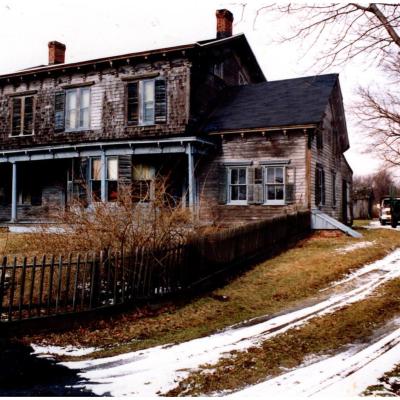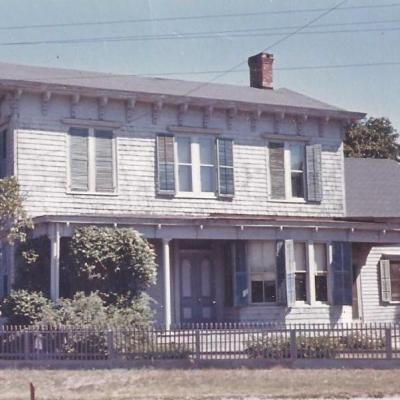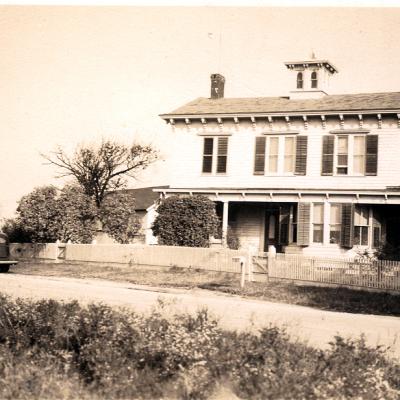The Smith Murder
November 13th, 1842
Old Fields, L.I.
The Murder of Alexander & Rebecca Smith

*The farmhouse did not have the second story at the time of the murders
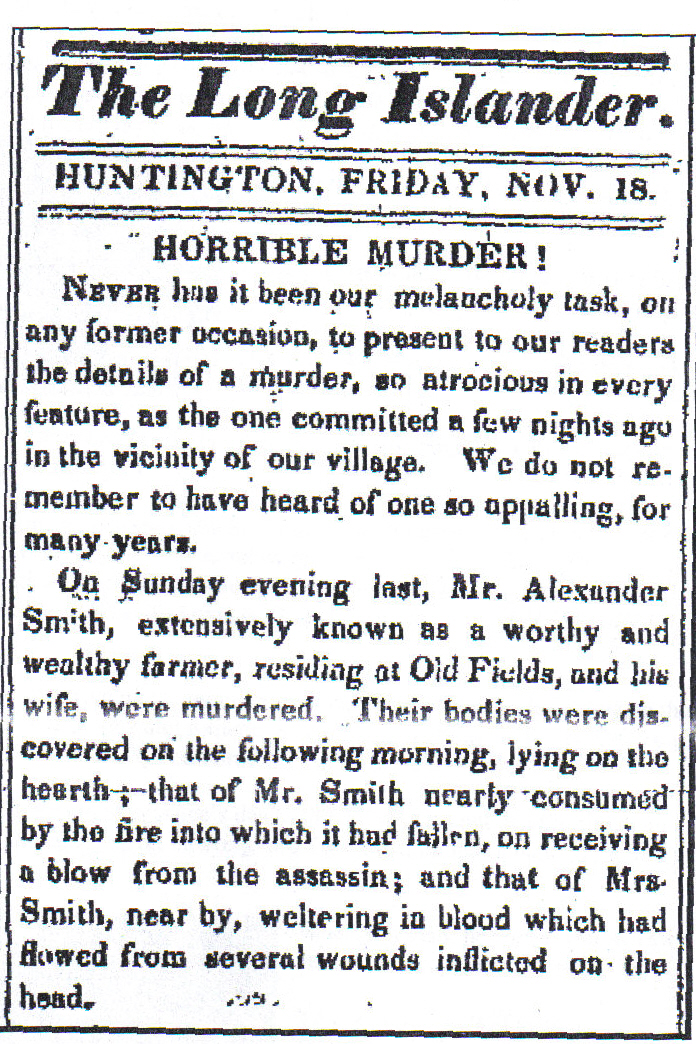
The Long-Islander - November 18, 1842
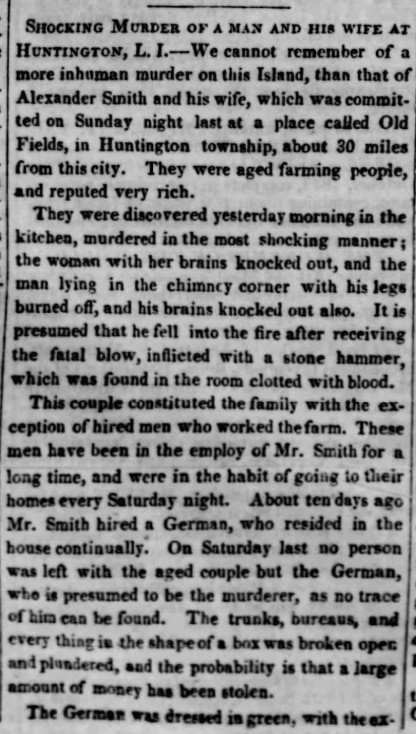
Brooklyn Evening Star - November 15, 1842
Click each tab to learn more!
On November 13, 1842, a grisly event occurred in the quiet farming community of what was then known as Old Fields. Prominent farmer Alexander Smith and his wife Rebecca were brutally murdered in the front parlor of their home, apparently while enjoying their evening tea.
Alexander and Rebecca Smith had owned their prosperous farm for years. The couple was well respected in the community, and their only child, Fanny, married into the Gardiners, another prominent family in the area. The crime was unusual in many respects. Although murder was prevalent in large cities such as Manhattan, violent crime was relatively unknown in the small farming communities that dotted the North Shore of Long Island. That the attack was committed against a respected older affluent couple made the crime all the more shocking and horrifying.
The murders were discovered around sunrise of the following morning, November 14, 1842, by George Weeks. Weeks, a nearby neighbor also worked at the farm. He immediately realized something was amiss when he noticed the family dog, who usually slept with Mr. Smith, locked in the work shop. He also observed that a window located at the east end of the house was broken out.
After proceeding to the front door, he noted that it was neither barred nor locked. Upon looking in the window, he observed Rebecca lying on the floor. Alarmed, Weeks ran home for help, and returned a few minutes later with two other neighbors, Mr. Selleck and Mr. Curren. Upon finally opening the door, the bodies of the couple were immediately discovered.
The Smiths appeared to have been left where they fell, and the position of the bodies suggested than Mr. Smith was struck first, while sitting in his customary chair in front of the large fireplace. He sustained several blows to the head, and fell into the fireplace. Much of the lower part of his body caught fire, most likely after death. Mrs. Smith was found in the center of the room, suggesting that she rose from her chair upon the attack. She, too, was struck several times about the head and body by a blunt instrument.
It was believed that the motive for the terrible crime was theft. At the time of the murders, the only person also known to have been in the house with the Smiths was Antoine Geisler, a recent immigrant from Germany who had been working as a farmhand for the Smiths for two weeks prior to the occurrence.
Mr. Geisler was nowhere to be found. The local newspapers put out the following descriptions with a $500 reward (around $20,000 today):
Brooklyn Evening Star, November 15, 1842:
“The German was dressed in green, with exception of his vest, and has a large mustachois. A large open slit on the side of one of his boots.
DUTCHMAN – stout built, 5 feet, 9 inches high, light hair, light eyes, rather large, with hair on the upper lip, about 25 years of age, his two front upper teeth stood apart, his dress green frock coat, green pants, a light checked vest, coarse strong boots, small green cap.”
The Corrector, November 16, 1842:
“Description of the Murderer – In highth, 5 feet, 8 or 6 inches, stout made, light complexion and light hair, large eyes, hair on his upper lip long, has not been shaved for some time, about 25 years of age; had on a small green cloth cap, green frock coat, and checkered vest, and green pantaloons, coarse boots, cracked open on both sides…”
The Brooklyn Weekly Eagle, November 17, 1842:
“We learn that a young foreigner, supposed to be a German, about 23 years of age, is suspected to have murdered a wealthy farmer and his wife near Huntington… He was dressed in a green coat and pantaloons, and wore a green cap. His boots were riped at the sides. He wore a mustache.”
He was searched for, and arrested, several days later in Port Jefferson. Despite his protestations of innocence, an inquest was held, and he was charged with the murder of the Smiths.
AI-generated Image (from newspaper descriptions)

The trial was originally scheduled to be held in May of 1843, but was postponed until the following September to allow Mr. Geisler to retain counsel. A lawyer was provided by the German Society in New York. The trial commenced on September 7, 1843 in Riverhead. After all the testimony was heard, Geisler was convicted of the double homicide. Even given the anti-immigrant sentiments of the day, there was apparently some public debate regarding his guilt. However, in November 1843, Antoine Geisler made out a full confession of the crimes, describing his actions in sufficient detail to convince most of the public of his guilt.
His confession was as follows, as published in the November 11, 1843, Brooklyn Eagle newspaper:
“My name is Stephen Keon, and I was born in Germany. I enlisted in the German army of my own accord, and after serving a short time deserted; and for fear of being taken, I changed my name and came to this country.
On the second Sunday after my arrival, I went to Mr. Smith’s, and while in the house heard him counting money, and this tempted me to contrive a plan to kill the old people and get possession of the money. On the following evening, after supper, Mr. Smith was sitting in his usual place, and Mrs. Smith was sitting opposite to him, and I sat behind Mr. Smith. Then I rose and went out of the house, the dog following me, and I shut the dog up in the outhouse, where I found the hammer. I took it, and returned to the room where the old people were sitting by the fire, and struck Mrs. Smith, and then Mr. Smith, and they both fell on the floor.
I then took the candle, went to the east room door, and it was fastened. I then went out, and broke in the east room window with the hammer. I crept in the window, opened the desk, got hold of a powder canister, and the candle went out. I then went out of the window, with the powder canister in my hand, and hurt my knee in getting out. When I came before the house and saw what I had in my hand, I threw it down and left it. I then went into the room where the dead bodies lay, and found Mr. Smith lying on the fire, partly consumed, and saw a vein in Mrs. Smith’s arm move, and this hurt my feelings. I then found an axe, and inflicted the rest of the wounds on him and then on Mrs. Smith. I looked at them and wept.
I then went out of the house to the watering pond, and threw the axe in, and went on, throwing away my old boots, where they were found. I continued on, stopping at different places, till I was taken in custody.”
In May 1844, he was sentenced to death, and on June 7, 1844, Antoine Geisler was executed by hanging.
His sentence was pronounced by Judge Ruggles in the May 31, 1844, Long-Islander newspaper:
“Antoine Geisler – You have had your trial – Your case has been patiently heard and impartially tried. The Jury have found you guilty of an atrocious crime, unequalled in the history of this county, and perhaps of the State. The evidence against you, though not positive, was yet strong, and left no doubt of your guilt. It is also understood that since your trial, you have confessed the commission of the crime. This was right. Struck by remorse, your troubled conscience could no longer conceal its guilt.
You stand convicted in a foreign country of a barbarous crime, with no friends to assist you – your own countrymen, satisfied with your guilt, have forsaken you. Your time is now short. It has already been protracted longer than usual. Your remaining days are few. They can be numbered, but their number is small. From the light of this world, you will soon be shut out, and it only remains for you to prepare for the future.
Your sentence is – that you be taken hence to the County Jail, there to be kept until the seventh day of June next, and on that day, between the hours of twelve at noon and two o’clock in the afternoon, to be hung by the neck until you be dead – and may God have mercy on your soul.
The prisoner then handed a letter to the Judge, signed Stephen Gron… being asked why the letter was signed Stephen Gron, he said that is my name. The prisoner evinced no emotion whatever while his sentence was pronounced…”
Articles from 1842
- “Shocking Murder.” Brooklyn Evening Star, November 15, 1842.
- “A Double Murder…” The Brooklyn Daily Eagle, November 15, 1842.
- “Horrible Outrage.” The New York Tribune (C.A.), November 15, 1842.
- Murder with Description. The Corrector (Sag Harbor) (S.C.H.N.), November 16, 1842.
- “Arrest of the Probable Murder…” The Brooklyn Daily Eagle, November 16, 1842.
- “The Murder at Old Fields.” The Brooklyn Daily Eagle, November 17, 1842.
- “Horrible Murder.” The Long Islander (S.C.H.N.), November 18, 1842.
- “Search for the Murderer.” The Corrector (Sag Harbor) (S.C.H.N.), November 19, 1842.
- Postmortem. Brooklyn Eagle, November 19, 1842.
- “Murderer Found in Port Jeff.” Brooklyn Evening Star, November 19, 1842.
- “The Long Islander Published…” The Brooklyn Daily Eagle, November 25, 1842.
- “Examination.” The Long Islander, November 25, 1842.
- “Examination.” Brooklyn Evening Star, November 26, 1842.
- “The Old Fields Murder.” Brooklyn Eagle, November 26, 1842.
- “The Old Fields Murder.” The Long Islander, December 30, 1842 (poem).
Articles from 1843
- Murder Poem Critic. The Long Islander, January 13, 1843.
- “Huntington Murder.” Brooklyn Eagle, May 18, 1843.
- “Trial Postponed.” The Long Islander, May 19, 1843.
- Newspaper in Court. The Long Islander, September 1, 1843.
- “Trial of Giesler.” The New York Tribune (C.A.), September 7, 1843.
- “The Suffolk County Murder.” The New York Herald (C.A.), September 7, 1843.
- “Trial of Giesler.” The Brooklyn Daily Eagle, September 8, 1843.
- “Trial of Antoine Giesler.” The New York Daily Tribune (C.A.), September 9, 1843.
- Little Doubt of Innocence. The Brooklyn Daily Eagle, September 9, 1843.
- “Suffolk County Murder.” The New York Herald (C.A.), September 9, 1843.
- “Giesler Convicted.” The Brooklyn Daily Eagle, September 11, 1843.
- Trial and Conviction of Giesler. The New York Daily Tribune (C.A.), September 11, 1843.
- Conviction and Trial Postponed. The New York Herald, September 11, 1843.
- “Trial of Giesler.” Brooklyn Weekly Eagle, September 14, 1843.
- “Trial of Antoine Giesler.” The Long Islander, September 15, 1843.
- “A Trip to Riverhead.” The Long Islander, September 22, 1843.
- “Trial of Giesler.” The Elmira Gazette, September 28, 1843.
- “Giesler the Murderer.” Brooklyn Evening Star, November 6, 1843.
- Trial of Giesler with Description. Brooklyn Evening Star, November 7, 1843.
- Confession Upcoming. Brooklyn Eagle, November 7, 1843.
- “Confession Confirmed.” Brooklyn Evening Star, November 8, 1843.
- “Confession of Giesler.” The Long Islander, November 10, 1843.
- “Confession of Giesler.” The Brooklyn Daily Eagle, November 11, 1843.
- “Convicted & Confessed.” The Middlebury Peoples Press (C.A.), November 15, 1843.
- “Confession of Geisler.” Sunbury American and Shamokin Journal (C.A.), November 18, 1843.
- “Geisler’s Confession.” The Madisonian (Washington, D.C.), November 20, 1843.
- “Antoine Geisler, Alias Stephen Kron.” The Long Islander, November 24, 1843.
- “Anthony Geisler.” The Long Islander, December 8, 1843.
Articles from 1844
- “Sentenced to Hanging.” The Long Islander, May 17, 1844.
- “Sentence of Antoine Geisler.” The Long Islander, May 31, 1844.
- “Geisler Hung.” The Long Islander, June 14, 1844.
- “Attended Hanging.” The Corrector (S.C.H.N.), June 15, 1844.
- “Riverhead, L.I., June 8, 1844 (Final)” The Long Islander, June 21, 1844.




